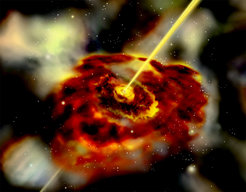
1. Probing the dusty environment of the Seyfert 1 nucleus in NGC 3783 with MIDI/VLTI interferometry
Beckert, T., Driebe, T., Hoenig, S., Weigelt, G.
Astronomy and Astrophysics, Volume 486, Issue 3, pp.L17-L20 (2008)
AbstractWe present mid-IR spectro-interferometry of the Seyfert type 1 nucleus of NGC 3783. The dusty circumnuclear environment is spatially resolved and the wavelength dependence of the compact emission is discussed. The observations were carried out with the MIDI instrument at the Very Large Telescope Interferometer in the N-band. Spectra and visibilities were derived with a spectral resolution of 30 in the wavelength range from 8 to 13 micron. For the interpretation we developed a simple dusty disk model with small and variable covering factor. At baselines of 65 and 69 m, visibilities in the range of 0.4 to 0.7 were measured. The N-band spectra show a monotonic increase of the measured flux with wavelength with no apparent silicate feature around 10 micron. We find that the mid-IR emission from the nucleus can be reproduced by an extended dust disk or torus with a small covering factor of the radiating dust clouds. Our mid-IR observations of NGC 3783 are consistent with a clumpy circumnuclear dust environment. The interpretation in terms of a dusty torus with low covering factor supports a clumpy version of the unified scheme for AGN. The inferred sizes and luminosities are in good agreement with dust reverberation sizes and bolometric luminosities from optical and X-ray observations.
You can get this publication by following this link to the ADS website.
2. Possible evidence for a common radial structure in nearby AGN tori
Kishimoto, M.; Hoenig, S.; Tristram, K.; Weigelt, G.
A&A Letters, Vol.493, Issue 3, pg.L57-L60 (2009)
AbstractWe present a quantitative and relatively model-independent way to assess the radial structure of nearby AGN tori. These putative tori have been studied with long-baseline infrared (IR) interferometry, but the spatial scales probed are different for different objects. They are at various distances and also have different physical sizes which apparently scale with the luminosity of the central engine. Here we look at interferometric visibilities as a function of spatial scales normalized by the size of the inner torus radius Rin. This approximately eliminates luminosity and distance dependence and, thus, provides a way to uniformly view the visibilities observed for various objects and at different wavelengths. We can construct a composite visibility curve over a large range of spatial scales if different tori share a common radial structure. The currently available observations do suggest model-independently a common radial surface brightness distribution in the mid-IR that is roughly of a power-law form r-2 as a function of radius r, and extends to ~100 times Rin. Taking into account the temperature decrease toward outer radii with a simple torus model, this corresponds to the radial surface density distribution of dusty material directly illuminated by the central engine roughly in the range between r0 and r-1. This should be tested with further data.
You can get this publication by following this link to the ADS website.
3. The characteristic blue spectra of accretion disks in quasars as uncovered in the infrared
Kishimoto, M., Antonucci, R., Blaes, O., Lawrence, A., Boisson, C., Albrecht, M., Leipski, C.
NATURE, Volume 454, Issue 7203, pp. 492-494 (2008)
AbstractQuasars are thought to be powered by supermassive black holes accreting surrounding gas. Central to this picture is a putative accretion disk which is believed to be the source of the majority of the radiative output. It is well known, however, that the most extensively studied disk model-an optically thick disk which is heated locally by the dissipation of gravitational binding energy-is apparently contradicted by observations in a few major respects. In particular, the model predicts a specific blue spectral shape asymptotically from the visible to the near-infrared, but this is not generally seen in the visible wavelength region where the disk spectrum is observable. A crucial difficulty has been that, towards the infrared, the disk spectrum starts to be hidden under strong, hot dust emission from much larger but hitherto unresolved scales, and thus has essentially been impossible to observe. Here we report observations of polarized light interior to the dust-emitting region that enable us to uncover this near-infrared disk spectrum in several quasars. The revealed spectra show that the near-infrared disk spectrum is indeed as blue as predicted. This indicates that, at least for the outer near-infrared-emitting radii, the standard picture of the locally heated disk is approximately correct.
You can get this publication by following this link to the ADS website.
